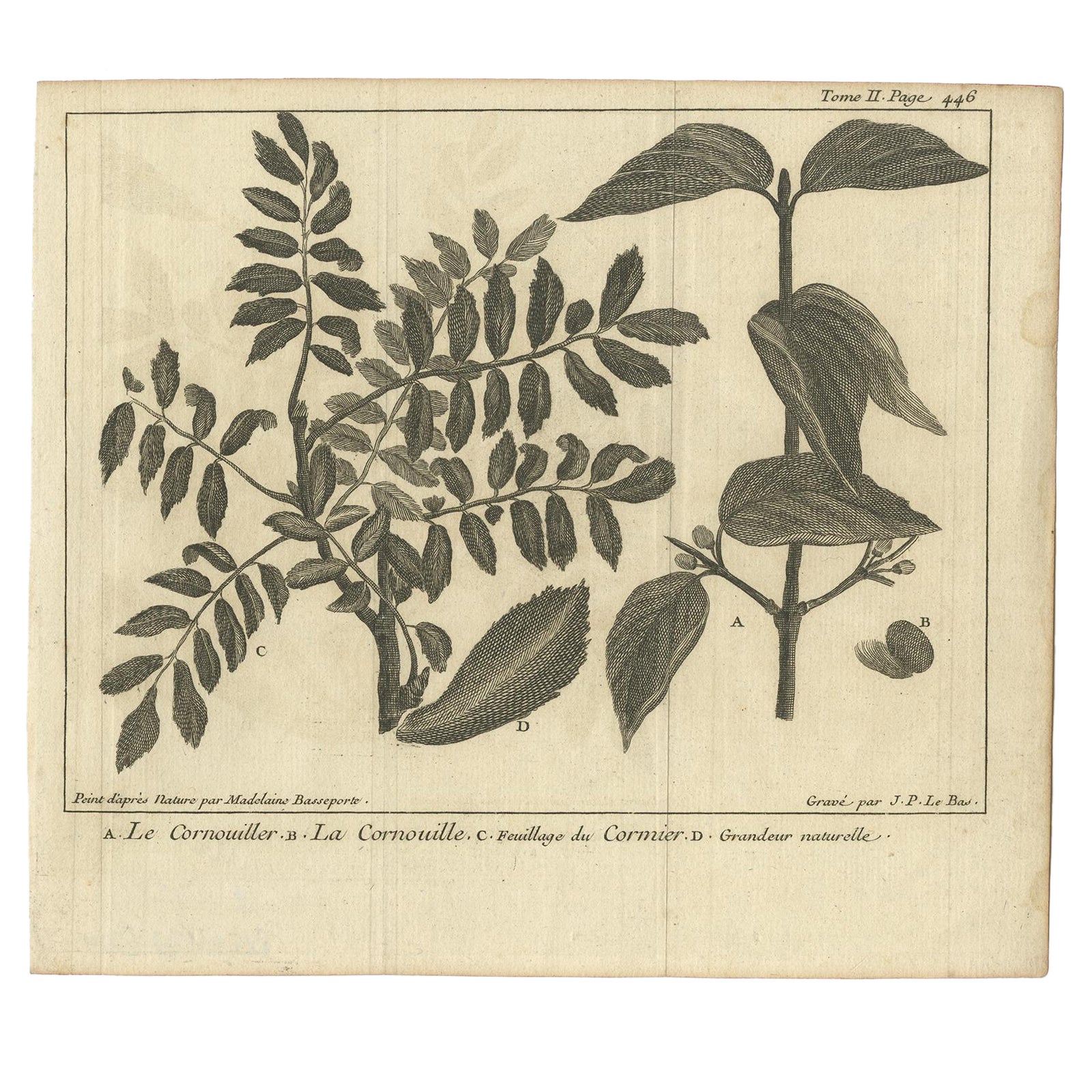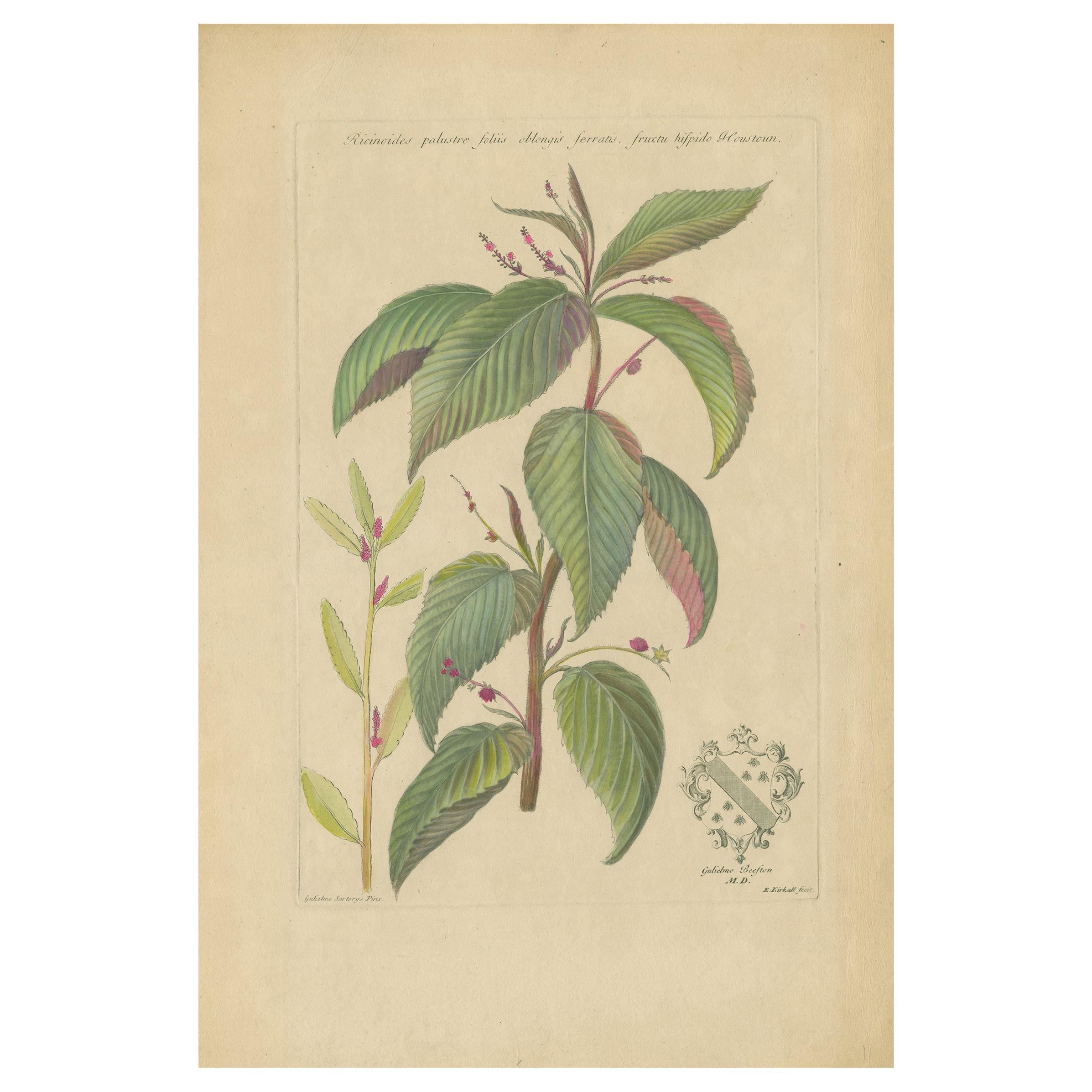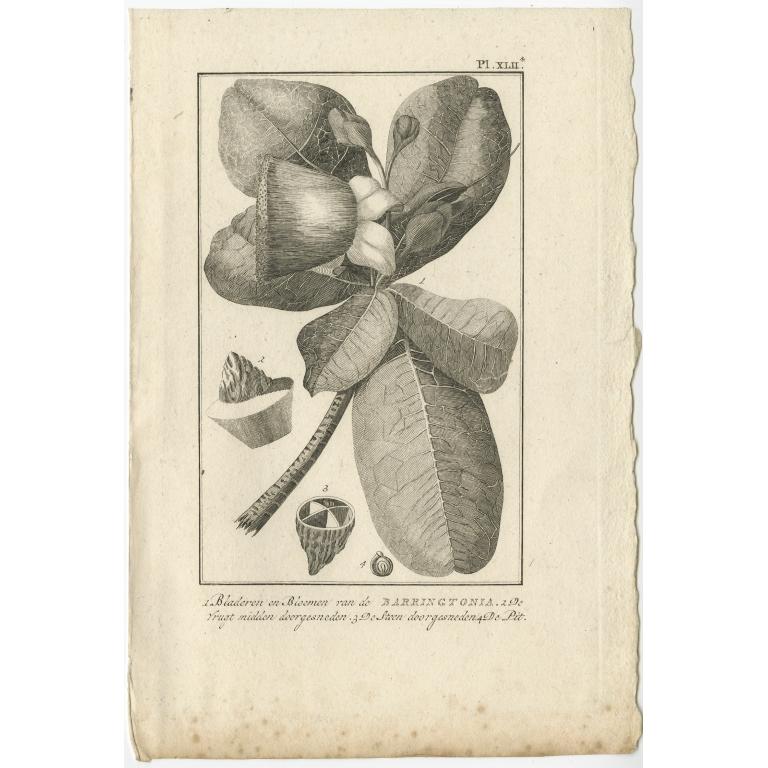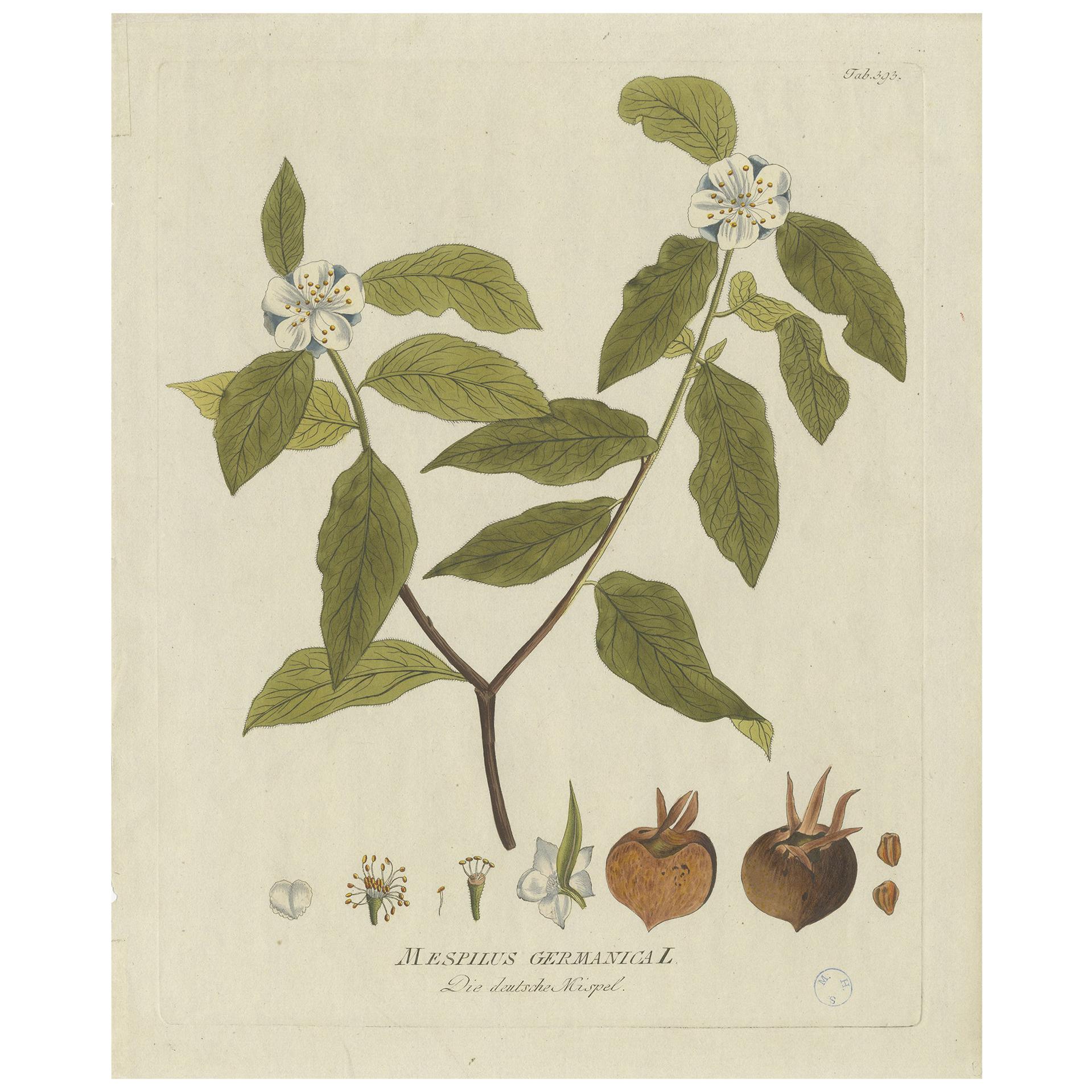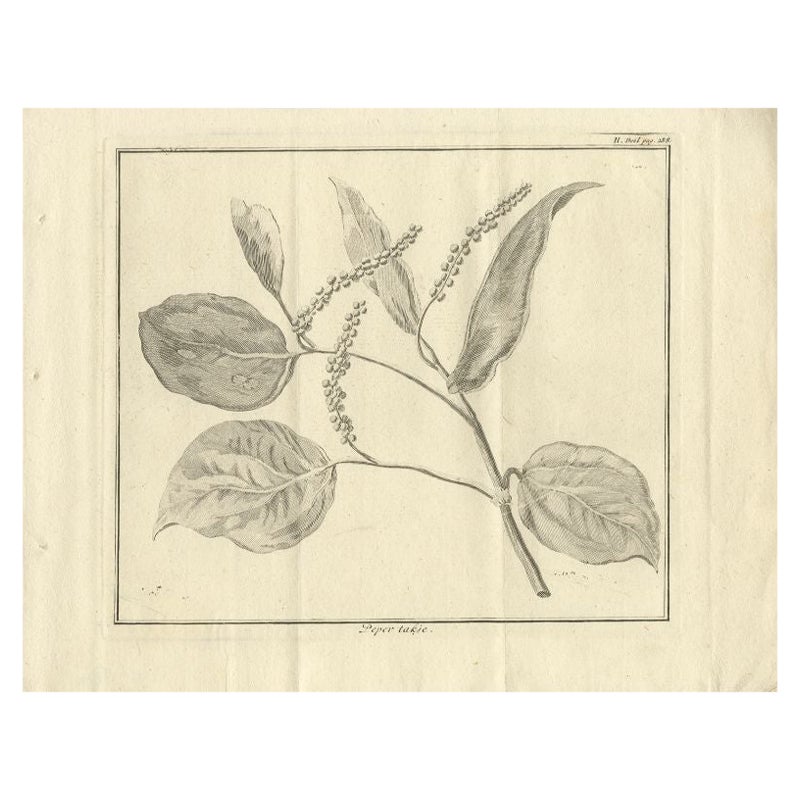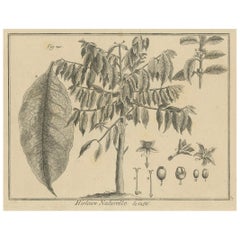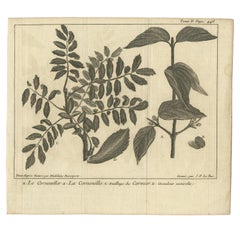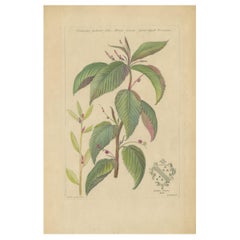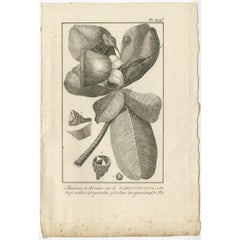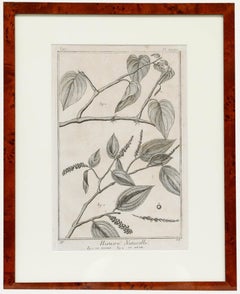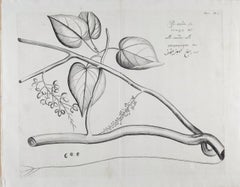Items Similar to Botanical Engraving of the Coffee Plant – Dutch Colonial Period, c.1737
Want more images or videos?
Request additional images or videos from the seller
1 of 10
Botanical Engraving of the Coffee Plant – Dutch Colonial Period, c.1737
$452.12
£338.41
€380
CA$621
A$694.35
CHF 364.22
MX$8,410.23
NOK 4,597.50
SEK 4,343.53
DKK 2,893.05
About the Item
Botanical Engraving of the Coffee Plant – Dutch Colonial Period, c.1737
This exquisite botanical engraving depicts the coffee plant in detailed scientific form, as it was studied and cultivated during the Dutch colonial era. Titled along the vertical border as “Tak van den Koffy Boom met zyne Bloemen en Vrugten” (Branch of the Coffee Tree with its Flowers and Fruits), the image was originally published in the early 18th century, most likely in association with works by Dutch botanists documenting the plants of the East and West Indies. This particular sheet dates to around 1737 and reflects the style and typographic layout found in botanical publications tied to colonial trade networks.
The large vertical illustration presents an elegant full-length view of a coffee plant stem, complete with clusters of pointed leaves, blossoms, and fruit at various stages of development. Below the main image are five carefully labeled vignettes showing different parts of the coffee plant: a dried fruit, the coffee husk, a ripe berry, and the bean or kernel (de Kers of Koffy Boon). Each part is rendered with careful linework, showcasing the clarity and precision typical of copperplate engraving used in early botanical studies.
This print not only reflects the scientific curiosity of the Enlightenment but also the economic importance of the coffee plant to the Dutch Republic, which played a central role in cultivating and exporting coffee from colonies in Java, Ceylon, and Surinam. It would have served as both a botanical record and a symbol of colonial power, trade, and scientific advancement.
Condition: Very good condition with a strong impression on laid paper. Light fold lines as issued (likely from a folio atlas or botanical volume). Slight age toning and minor edge wear. No tears or repairs.
Framing tips: This elegant vertical print is ideal for a narrow frame in dark wood or ebonized finish. A natural cream or light tan mat will complement the botanical subject. For maximum impact, consider museum glass to preserve and highlight the fine linework.
Technique: Copperplate engraving
Maker: Anonymous Dutch engraver, after a botanical model, circa 1737
- Dimensions:Height: 15.36 in (39 cm)Width: 7.68 in (19.5 cm)Depth: 0.01 in (0.2 mm)
- Materials and Techniques:Paper,Engraved
- Place of Origin:
- Period:1730-1739
- Date of Manufacture:circa 1737
- Condition:Condition: Very good condition with a strong impression on laid paper. Light fold lines as issued (likely from a folio atlas or botanical volume). Slight age toning and minor edge wear. No tears or repairs.
- Seller Location:Langweer, NL
- Reference Number:Seller: BG-11491-61stDibs: LU3054346155042
About the Seller
5.0
Recognized Seller
These prestigious sellers are industry leaders and represent the highest echelon for item quality and design.
Platinum Seller
Premium sellers with a 4.7+ rating and 24-hour response times
Established in 2009
1stDibs seller since 2017
2,565 sales on 1stDibs
Typical response time: <1 hour
- ShippingRetrieving quote...Shipping from: Langweer, Netherlands
- Return Policy
Authenticity Guarantee
In the unlikely event there’s an issue with an item’s authenticity, contact us within 1 year for a full refund. DetailsMoney-Back Guarantee
If your item is not as described, is damaged in transit, or does not arrive, contact us within 7 days for a full refund. Details24-Hour Cancellation
You have a 24-hour grace period in which to reconsider your purchase, with no questions asked.Vetted Professional Sellers
Our world-class sellers must adhere to strict standards for service and quality, maintaining the integrity of our listings.Price-Match Guarantee
If you find that a seller listed the same item for a lower price elsewhere, we’ll match it.Trusted Global Delivery
Our best-in-class carrier network provides specialized shipping options worldwide, including custom delivery.More From This Seller
View AllDetailed Botanical Engraving of the Coffee Plant from Histoire Naturelle, c.1780
Located in Langweer, NL
This engraving titled "Histoire Naturelle: le café" is a detailed botanical illustration, part of an 18th or 19th-century natural history text or compendium.
It depicts the coffee ...
Category
Antique Late 18th Century Prints
Materials
Paper
$152 Sale Price
20% Off
Antique Botany Print of Dogwood by Le Bas, 1752
Located in Langweer, NL
Antique print titled ‘A. Le Cornouiller, B. La Cornouille, C. Feuillage du Cormier, D. Grandeur Naturelle’. Beautiful print depicting dogwood. This print originates from ‘Le spectacl...
Category
Antique 18th Century Prints
Materials
Paper
$90 Sale Price / item
20% Off
Antique Botany Print of a Caperonia Species, 'circa 1730'
Located in Langweer, NL
Antique botany print titled 'Ricinoides palustre foliis (..)'. Original antique print of a Caperonia species. This print originates from 'Historia plantarum rariorum' by John Martyn.
Category
Antique Mid-18th Century Prints
Materials
Paper
$285 Sale Price
20% Off
Antique Botany Print of The Barringtonia Plant by Cook, 1803
Located in Langweer, NL
The antique botany print, titled 'Bladeren en Bloemen van de Barringtonia,' portrays the leaves and flowers of the Barringtonia plant. This plant, renowned for its unique feature of ...
Category
Antique 19th Century Prints
Materials
Paper
$161 Sale Price
20% Off
Antique Botany Print of the Mespilus Germanica by Plenck 'circa 1790'
Located in Langweer, NL
Antique botany print titled 'Mespilus Germanica'. Hand colored engraving of the mespilus germanica, also known as the medlar or common medlar. This print originates from 'Icones Plan...
Category
Antique Late 18th Century Prints
Materials
Paper
$237 Sale Price
20% Off
Antique Print of a Pepper Branch, 1739
Located in Langweer, NL
Antique print titled 'Peper-Takje'. Copper engraving of a pepper branch. This print originates from: 'Hedendaagsche Historie, of tegenwoordige staat van alle volkeren II deel ', publ...
Category
Antique 18th Century Prints
Materials
Paper
$114 Sale Price
20% Off
You May Also Like
Robert Béenard (1734-1794) - 18th Century Engraving, Le Pivre & Le Betel
Located in Corsham, GB
Well presented in a simple mahogany frame and cream mount. On wove.
Category
Early 18th Century Still-life Prints
Materials
Engraving
Apocynum androsamifolium - French botanical flower engraving by Bessa, c1830
By After Pancrace Bessa
Located in Melbourne, Victoria
'Apocynum androsamifolium' (Fly-trap dogbane or spreading dogbane)
Original copper-line engraving with original hand-colouring.
From 'Herbier general de l'amateur' by Jean Louis A...
Category
Early 19th Century Naturalistic Still-life Prints
Materials
Engraving
Citamerdu (Amrita) Plant: 17th Century Botanical Engraving by Hendrik van Rheede
Located in Alamo, CA
This is a rare 17th century engraving of a plant entitled "Citamerdu" by the Dutch botanist Hendrik van Rheede tot Drakenstein, plate 21 from his 'Hortus Indicus Malabaricus' (Garden of Malabar), published in Amsterdam in 1686 by Johann van Someren. The engraving depicts the Citamerdu plant, also known as Tinospora cordifolia plant or Amrita and Guduchi. It is a deciduous plant with heart-shaped leaves, greenish flowers, and pea-shaped fruits. Rheede's 19th century publication featured illustrations of exotic plants and fruits labelled with script in the upper right corner in Latin, Malay, Arabic, and Sanskrit. Hortus Indicus Malabaricus is believed to be the earliest comprehensive published work on the flora of Asia and the tropics. The 17th century treatise featured important illustrations of 740 plants of the region, including Indian medicinal plants.
The engraving is printed on 17th century laid, chain-linked paper, watermarked with an elaborate crown design. The sheet measures 15.75" high by 18.75" wide. There is a central fold, as issued. There are a few small spots, but the print is otherwise in excellent condition.
There are additional Rheede botanical engravings from his 'Hortus Indicus Malabaricus' publication that are listed on my 1stdibs storefront and online website. These would make for an impressive display grouping. A discount is available for purchase of two or more of the prints.
Hendrik Adriaan van...
Category
Late 17th Century Naturalistic Landscape Prints
Materials
Engraving
Pee-amerdu Plant: A Rare 17th Century Botanical Engraving by H. van Rheede
Located in Alamo, CA
This is a rare 17th century engraving of a plant entitled "Pee-amerdu" by the Dutch botanist Hendrik van Rheede tot Drakenstein, plate 19 from his 'Hortus Indicus Malabaricus' (Garden of Malabar), published in Amsterdam in 1686 by Johann van Someren. The engraving depicts the Pee-amerdu plant, a large leafed plant climbing plant off the Malabar Coast in India. The plant is noted for its medicinal uses. It may be related to Tinospora species. Rheede's 19th century publication featured illustrations of exotic plants and fruits labelled with script in the upper right corner in Latin, Malay, Arabic, and Sanskrit. Hortus Indicus Malabaricus is believed to be the earliest comprehensive published work on the flora of Asia and the tropics. The 17th century treatise featured important illustrations of 740 plants of the region, including Indian medicinal plants.
The engraving is printed on 17th century laid, chain-linked watermarked paper. The sheet measures 14.88" high by 18.75" wide. There is a central fold, as issued. There are a few faint smudges, a spot in the upper margin and there is minimal irregularity of the left edge of the paper where the print was previously bound in the 17th century publication. The print is otherwise in very good condition.
There are additional Rheede botanical engravings from his 'Hortus Indicus Malabaricus' publication that are listed on my 1stdibs storefront and online website. These would make for an impressive display grouping. A discount is available for purchase of two or more of the prints.
Hendrik Adriaan van Rheede tot Drakenstein...
Category
Late 17th Century Naturalistic Landscape Prints
Materials
Engraving
Quivisia; Portesia /// Antique Botanical Botany Plants Science Engraving Buffon
By Georges-Louis Leclerc, Comte de Buffon
Located in Saint Augustine, FL
Artist: Georges-Louis Leclerc, Comte de Buffon (French, 1707-1788)
Title: "Quivisia; Portesia" (Octandreie, Monogynie, Plate 302)
Portfolio: Histoire Naturelle
Year: 1749-1789
Medium: Original Hand-Colored Engraving on laid paper
Limited edition: Unknown
Printer: Imprimerie Nationale, Paris, France
Publisher: Georges-Louis Leclerc, Comte de Buffon, Paris, France
Framing: Not framed, but beautifully double matted with hand decorated archival French matting...
Category
2010s Naturalistic Still-life Prints
Materials
Watercolor, Engraving, Laid Paper, Intaglio
Robert Béenard (1734-1794) - 18th Century Engraving, Le Quinquina & La Casse
Located in Corsham, GB
Well presented in a simple mahogany frame and cream mount. On wove.
Category
Early 18th Century Still-life Prints
Materials
Engraving

